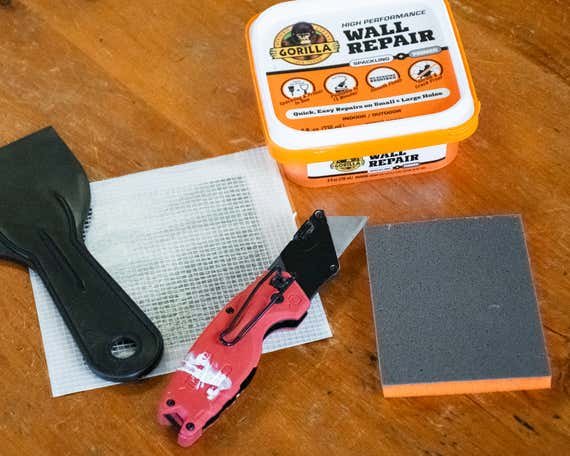
What you need:
First, evaluate the hole. If it’s a minor dent or a pinhole, you can just get a little spackle and a putty knife and fill it in, no kit required. You may even address a pinhole with just a dab of paint. If what you’re looking at is an actual hole—something you can push a finger through—it’s time to get a patch kit. If you merely blob spackle into a hole without any backing support, it’ll just keep falling into the hole; you may eventually get it to look nice, but it will remain a weak point that’s likely to break again.

Once you decide it’s time for a patch kit, clean up the edges of the hole. Drywall is abrasive, so use a utility knife—since the blades are disposable, you don’t have to worry about trashing the edge. Cut along the outside of the hole, making sure to remove any frayed bits of paper or chunky clumps of the drywall. You’ll be applying what is basically a giant sticker to the hole, so if anything protrudes from the wall, the end result won’t be as good.

With the hole cleaned up, apply the patch. These differ from brand to brand, but the patch in the Gorilla kit is a cloth scrim with a thin sheet of aluminum as a backer, so the spackle doesn’t just endlessly fall into the hole. The patch has a sticky side; to apply it, put it over the hole and use the putty knife to press it in, starting at the center and working out toward the edges.

Then, glop on some spackle. Take the included putty knife and give the spackle a stir, which helps it go on smoothly. Scoop out a bunch and start spreading it over the hole. Firmly pressing the putty knife as you spread produces nicer results, smoothing the spackle as you apply it. Make it thick enough to completely cover the cloth scrim but not so thick that it feels like a giant bulge on the wall.
You can extend the spackle a few inches out in each direction from the patch to properly feather it into the wall, but don’t stress about getting it perfect on the first try. The Gorilla kit gives you plenty of spackle, so applying a second (and third and fourth) coat, if necessary, is no big deal.
I prefer to go lighter on the first coat, usually anticipating a second. I’d rather apply a second round than have to sand off an excessive amount—too much sanding can lead to an uneven surface.
Let it dry. You’ve done great so far. Take a break and let it dry. Depending on the temperature and humidity, drying usually takes a few hours. I usually just wait till the next day.
Sand it until it looks nice. Once it’s dry, take the included sanding sponge, put on a dust mask, and sand it as flat as you can while leaving enough spackle to prevent the cloth scrim from showing through. The wall patch will create a very slight bump. If you’re not satisfied with the result, or if the cloth scrim is showing through, you can always add more spackle and feather it into a wider area. As a carpenter friend once told me, “The only way to fix a bump in drywall is to make a bigger bump.”
Once you get to a place where you’re happy, paint the patch. Depending on the age of your wall’s paint or how much it has faded, you may need to repaint the entire wall, even if you have a can that is a direct color match. You have no need to prime the Gorilla patch. I start with rolling on two coats directly over the patch and seeing how it looks. If the color or sheen is off, I just repaint the whole wall
Source link
[og_img

What you need:
First, evaluate the hole. If it’s a minor dent or a pinhole, you can just get a little spackle and a putty knife and fill it in, no kit required. You may even address a pinhole with just a dab of paint. If what you’re looking at is an actual hole—something you can push a finger through—it’s time to get a patch kit. If you merely blob spackle into a hole without any backing support, it’ll just keep falling into the hole; you may eventually get it to look nice, but it will remain a weak point that’s likely to break again.

Once you decide it’s time for a patch kit, clean up the edges of the hole. Drywall is abrasive, so use a utility knife—since the blades are disposable, you don’t have to worry about trashing the edge. Cut along the outside of the hole, making sure to remove any frayed bits of paper or chunky clumps of the drywall. You’ll be applying what is basically a giant sticker to the hole, so if anything protrudes from the wall, the end result won’t be as good.

With the hole cleaned up, apply the patch. These differ from brand to brand, but the patch in the Gorilla kit is a cloth scrim with a thin sheet of aluminum as a backer, so the spackle doesn’t just endlessly fall into the hole. The patch has a sticky side; to apply it, put it over the hole and use the putty knife to press it in, starting at the center and working out toward the edges.

Then, glop on some spackle. Take the included putty knife and give the spackle a stir, which helps it go on smoothly. Scoop out a bunch and start spreading it over the hole. Firmly pressing the putty knife as you spread produces nicer results, smoothing the spackle as you apply it. Make it thick enough to completely cover the cloth scrim but not so thick that it feels like a giant bulge on the wall.
You can extend the spackle a few inches out in each direction from the patch to properly feather it into the wall, but don’t stress about getting it perfect on the first try. The Gorilla kit gives you plenty of spackle, so applying a second (and third and fourth) coat, if necessary, is no big deal.
I prefer to go lighter on the first coat, usually anticipating a second. I’d rather apply a second round than have to sand off an excessive amount—too much sanding can lead to an uneven surface.
Let it dry. You’ve done great so far. Take a break and let it dry. Depending on the temperature and humidity, drying usually takes a few hours. I usually just wait till the next day.
Sand it until it looks nice. Once it’s dry, take the included sanding sponge, put on a dust mask, and sand it as flat as you can while leaving enough spackle to prevent the cloth scrim from showing through. The wall patch will create a very slight bump. If you’re not satisfied with the result, or if the cloth scrim is showing through, you can always add more spackle and feather it into a wider area. As a carpenter friend once told me, “The only way to fix a bump in drywall is to make a bigger bump.”
Once you get to a place where you’re happy, paint the patch. Depending on the age of your wall’s paint or how much it has faded, you may need to repaint the entire wall, even if you have a can that is a direct color match. You have no need to prime the Gorilla patch. I start with rolling on two coats directly over the patch and seeing how it looks. If the color or sheen is off, I just repaint the whole wall
How to Patch Drywall (And the Best Kit to Use)
[title_words_as_hashtags



